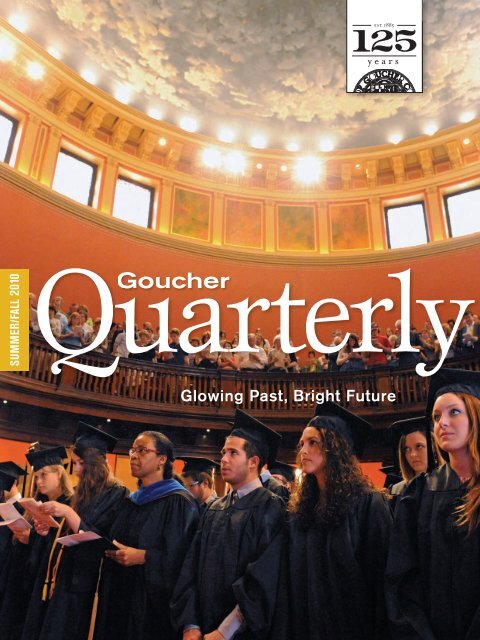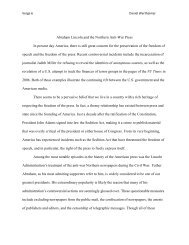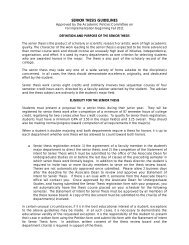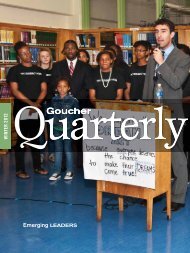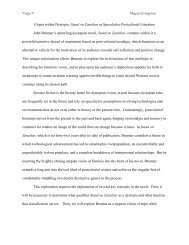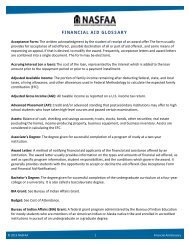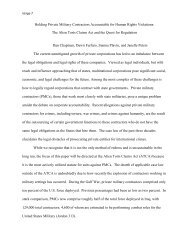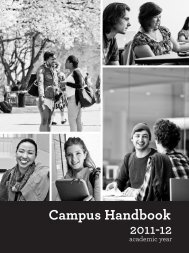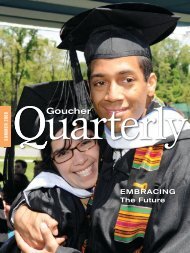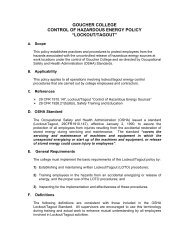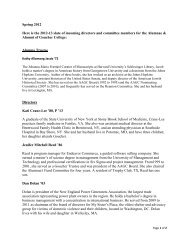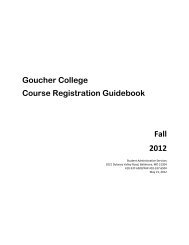Download Printable PDF - Goucher College
Download Printable PDF - Goucher College
Download Printable PDF - Goucher College
You also want an ePaper? Increase the reach of your titles
YUMPU automatically turns print PDFs into web optimized ePapers that Google loves.
SUMMER/FALL 2010<br />
uarterly<br />
<strong>Goucher</strong><br />
Glowing Past, Bright Future
14 alumnae/i weekend 2010<br />
A man on a horse, great friends, and a 125th birthday bash<br />
18 colorful research<br />
22<br />
<strong>Goucher</strong>’s<br />
A professor and student collaborate to explore a rare<br />
neurological phenomenon.<br />
toasting the ’10s<br />
119th Commencement celebrates the<br />
past and future.<br />
3 | goucher TODAY<br />
6 | giving to GOUCHER<br />
8 | gopheREPORT<br />
10 | alumnae/iUPDATE<br />
26 | impromptu<br />
27 | class NOTES<br />
57 | viewPOINT<br />
photo by Stan Rudick
uarterly<br />
<strong>Goucher</strong><br />
Vol. XCI No.2 Summer/Fall 2010<br />
on the front cover:<br />
In honor of the college’s 125th<br />
anniversary, Baccalaureate 2010 was<br />
held at the Lovely Lane United<br />
Methodist Church, where John F.<br />
<strong>Goucher</strong> was minister.<br />
Photo by Jim Burger<br />
on preceding page:<br />
The new labyrinth was dedicated<br />
during Alumnae/i Weekend.<br />
Photo by Stan Rudick<br />
editor<br />
Holly Selby<br />
copy editing<br />
Office of Communications<br />
design<br />
B. Creative Group, Inc.<br />
<strong>Goucher</strong> <strong>College</strong><br />
president<br />
Sanford J. Ungar<br />
vice president for development<br />
and alumnae/i affairs<br />
Janet Wiley<br />
assistant vice president for<br />
development and alumnae/i affairs<br />
Margaret-Ann Radford-Wedemeyer<br />
president, AAGC<br />
Katherine E. Healy ’78<br />
The <strong>Goucher</strong> Quarterly<br />
(USPS 223-920) is published by the<br />
Alumnae/i of <strong>Goucher</strong> <strong>College</strong>,<br />
Baltimore, Maryland 21204.<br />
Periodical postage is paid at Baltimore.<br />
postmaster<br />
Send address changes to:<br />
<strong>Goucher</strong> Quarterly<br />
<strong>Goucher</strong> <strong>College</strong><br />
1021 Dulaney Valley Road<br />
Baltimore, MD 21204-2794<br />
inquiries<br />
<strong>Goucher</strong> Quarterly:<br />
quarterly@goucher.edu<br />
or fax 410.337.6185<br />
Alumnae/i Affairs:<br />
1.800.272.2279 or 410.337.6180<br />
<strong>College</strong> Switchboard:<br />
1.800.GOUCHER<br />
Admissions: 410.337.6100<br />
as of September 2009<br />
total students: 1,481 undergraduates,<br />
798 graduate students<br />
total under graduate faculty: 218<br />
alumnae & alumni: 16,978<br />
photo by Rachel Stark ’09<br />
contributors<br />
Lindsay Stuart Hill ’09<br />
Lindsay Stuart Hill is the editorial assistant at the <strong>Goucher</strong> Quarterly.<br />
At <strong>Goucher</strong>. she majored in English, with a creative writing<br />
concentration, and received two Kratz fellowships to write poetry<br />
in Ireland and at the Zen Mountain Monastery in upstate New York.<br />
Her poem “One Life” was recently published in The Norton Pocket<br />
Book of Writing by Students, and last fall, she was the poet in residence<br />
at Baltimore’s Carver Center for Arts and Technology.<br />
Her profile of Florence Hochschild Austrian 1910 appears in this<br />
issue (see p. 6).<br />
Billie Weiss ’11<br />
Billie Weiss, editor-in-chief of The Quindecim, is majoring in<br />
communications and media studies. He spent the summer working<br />
as the multimedia intern for The Baltimore Sun. During the summer<br />
of 2009, he was the photography intern for the Baltimore Orioles. The<br />
Orioles chose one of his photos for their “This Is Birdland” campaign;<br />
it can be seen on billboards, street signs, and buses throughout the<br />
city. His photos, including those of the Kente cloth ceremony, appear<br />
throughout this issue.<br />
Many thanks go out to all the<br />
talented people who help produce<br />
this publication each quarter.<br />
<strong>Goucher</strong> <strong>College</strong> is a private<br />
liberal arts and sciences college<br />
founded in 1885. For up-to-date<br />
information about the college,<br />
visit www.goucher.edu.<br />
photo by Howie Lee Weiss
A Family<br />
Celebration<br />
For the past year, we’ve been celebrating <strong>Goucher</strong>’s 125th anniversary: We’ve<br />
shared stories of years gone by, thrown parties, and sent a team of students called<br />
the Vagabonds up and down the Eastern Seaboard to introduce themselves to<br />
alumnae/i. <strong>Goucher</strong>’s friends and supporters have toasted the college at events held from<br />
Baltimore to Boston and Bangkok to Jerusalem. Some of the gatherings were considerably<br />
larger than any party I am likely to have for myself—the 125th Anniversary Gala<br />
Reception held April 24 in the Athenaeum (see p. 17) attracted more than 500 people. A<br />
few events were held in impressive places such as the Restaurant at the Getty in Los<br />
Angeles or were hosted by illustrious folks such as Monica Pope ’85, a critically<br />
acclaimed chef whose Houston, TX, restaurant hews to environmentally conscious practices.<br />
Throughout the year, members of the <strong>Goucher</strong> community were also busy with<br />
other activities that celebrate John Franklin <strong>Goucher</strong>’s deep belief in the transformative<br />
power of education in a very different way. Inside the magazine, you’ll find a story about<br />
research into a rare neurological phenomenon called synesthesia conducted jointly by<br />
Carol Mills, <strong>Goucher</strong> professor emerita of psychology, and Shari Metzger ’07 (see p. 18).<br />
You’ll find information about the college’s new environmental studies major (see p. 5) and<br />
a profile of Esther Hyneman ’60, who, after retiring as a college professor, found a new<br />
passion: working to support women living in Afghanistan (see p. 12). There’s also a letter<br />
home from <strong>College</strong> Trustee and U. S. Marine Corps Major Percy Moore ’95 (see p.<br />
44), who celebrated his birthday with fellow <strong>Goucher</strong> alumnus and former soccer<br />
teammate Major Steve Taylor ’95 while deployed in Afghanistan. As Moore mentions<br />
in his letter, Taylor’s presence represented a chance to mark a special occasion with the<br />
closest thing he has to family in a faraway land—a fellow <strong>Goucher</strong> graduate.<br />
Anniversaries and birthdays are often occasions when we look ahead as well as<br />
back. Members of the class of 2014 are just now getting to know the campus and the<br />
faculty and staff—and just beginning to chart new paths. And in the years to come, they,<br />
too, as members of the <strong>Goucher</strong> family, will be invited to toast the college and its future.<br />
EDITOR’S NOTE<br />
1<br />
Best regards,<br />
Holly Selby | Editor<br />
holly.selby@goucher.edu
SPRING 2010<br />
<strong>Goucher</strong><br />
uarterly<br />
by mail<br />
<strong>Goucher</strong> Quarterly<br />
1021 Dulaney Valley Rd.<br />
Baltimore, MD 21204<br />
by e-mail<br />
quarterly@goucher.edu<br />
TELLING<br />
HISTORY<br />
feedback<br />
Letters should be 250 words or<br />
fewer (longer letters may be edited<br />
for length) and must be accompanied<br />
by sender’s name, daytime<br />
phone, and current address.<br />
Submissions will be edited for<br />
clarity and style. Publication will<br />
be as space permits.<br />
| SUMMER/FALL 2010<br />
2GOUCHER QUARTERLY<br />
Heartfelt Thanks<br />
In early 2010, my grandmother, Josephine Farkas Newman<br />
’43, told me how much fun she had at a 125th anniversary<br />
celebration in Palm Beach, FL. She told me about the<br />
blue-and-yellow balloons, the cake, the 125th napkins, and<br />
looking through pictures of <strong>Goucher</strong> with fellow alums. This<br />
made me really excited about attending the big Baltimore<br />
birthday bash being held during my 10th Reunion weekend.<br />
It was really neat to enjoy the same napkins, balloons, cake,<br />
and pictures my grandmother enjoyed. The Athenaeum<br />
is beautiful, and the Gala seemed extra special since it<br />
reminded me not only of my experience at <strong>Goucher</strong>, but<br />
also of my grandmother’s. Thank you, <strong>Goucher</strong>, for giving us<br />
an education appreciated by many generations and for<br />
celebrating 125 years of great education with festivities<br />
enjoyed by all.<br />
Lydia Newman ’00<br />
Looking for a Cookbook<br />
I am a graduate of the Class of 1979. During my junior year, I<br />
edited a cookbook and sold it for the profit of the Chemistry<br />
Club. We sold a lot of the books, and I’m hoping I can locate<br />
one of them. The name of the book was The Joys of Organic<br />
Chemistry. The main reason I want to find one is that it<br />
contains a lot of my family recipes. My mother passed away,<br />
and I have misplaced my copy. I’d love information about how<br />
to obtain one of the books.<br />
Lisa Matrozza ’79<br />
If anyone has information about how to obtain a cookbook,<br />
please contact the Quarterly at quarterly@goucher.edu.<br />
Don’t miss the fun!<br />
Mark your calendars; it is never too soon<br />
to begin planning for Alumnae/i Weekend.<br />
Here are the upcoming dates:<br />
2011<br />
April 29, 30, & May 1<br />
2012<br />
April 27–29<br />
2014<br />
April 25–27<br />
2015<br />
April 24–26<br />
2013<br />
April 26–28<br />
(L to R) Sarah Stockbridge ’00, Katie Lugli ’10, and Lydia Newman ’00
Moments of reflection—<br />
and of thanks<br />
<strong>Goucher</strong>’s Kente cloth ceremony<br />
goucher Today<br />
people | programs | events<br />
Amid the hustle and bustle of the end-of-semester<br />
festivities, 14 students paused for a few<br />
moments to reflect and to thank those people<br />
who have supported them with love, mentorship, and<br />
friendship. The Donning of the Kente Cloth is a rite of<br />
passage undertaken by graduating seniors on college<br />
campuses nationwide. Now in its fifth year at <strong>Goucher</strong>,<br />
the ceremony allows student members of the African<br />
diaspora and communities of color to use stories, songs,<br />
or poetry to honor their heritage, experiences, and<br />
achievements, as well as those who have helped them<br />
along the way. §<br />
“In a society that tends to<br />
GOUCHER TODAY<br />
shy away from acknowledging<br />
and exploring the<br />
3<br />
differences among us,<br />
this ceremony celebrates<br />
those differences and<br />
puts them on display,” says Kimberley Gordy<br />
’06, assistant director of admissions and coordinator<br />
of multicultural recruitment. “It allows<br />
Photos by Billie Weiss ’11<br />
these individuals to integrate their heritages—<br />
verbally and symbolically—into the meaningful<br />
milestone of college graduation.”<br />
TOP: Elyse Morris ’10 introducing Professor<br />
Kelly Brown Douglas, keynote speaker<br />
MIDDLE: Candace Chance ’10 lights a memorial candle<br />
as her brother, Duane Cooke, looks on.<br />
BOTTOM: Candra Scott ’10 and her father, Carlos Scott
goucherToday<br />
| SUMMER/FALL 2010<br />
4GOUCHER QUARTERLY<br />
Cooking the books<br />
On April 1, students, staff, and faculty gathered at the library to display their culinary<br />
creations at <strong>Goucher</strong>’s fi rst Edible Book Fest. Sponsored by the <strong>Goucher</strong> <strong>College</strong><br />
Library, the lighthearted competition had only two rules: Entries had to refer to a<br />
work of literature, and they had to be edible. Viewers voted for their favorites. The<br />
winners? <strong>Goucher</strong> Librarian Nancy Magnuson’s pig-shaped cake titled Mansfi eld<br />
Pork was named Most Culinary; Are You There, God? It’s Me, Margarine, submitted<br />
by Maura Roth-Gormley ’10, took the prize for Funniest entry; and the student<br />
team of Debra Lenik ’10 and Miriam Cummons ’11 won Most Literary and Best<br />
in Show for a cake titled All Quiet on the Western Bundt. §<br />
Singer, songwriter, and guitarist<br />
Manno Charlemagne<br />
Two Voices From Haiti<br />
By Lindsay Stuart Hill ’09<br />
Author Edwidge Danticat, President Sanford J. Ungar, and<br />
singer Manno Charlemagne discuss contemporary Haiti.<br />
“We will fi ght until the corn is ripe, until we are free.” These lyrics, translated<br />
from Haitian Creole, were written by singer, songwriter, and guitarist Manno<br />
Charlemagne, who, with author Edwidge Danticat, came to campus on April 8<br />
to give voice to Haiti’s struggles. The Arsht Center for Ethics and Leadership<br />
sponsored the event, which took place in the Hyman Forum of the Athenaeum.<br />
Called “the Bob Marley of Haiti,” Charlemagne was twice forced into exile<br />
and tortured multiple times for his political stances. His songs address the<br />
injustices that have plagued Haiti and draw on a tradition of oral storytelling. From<br />
1995 to 1999, he served as the mayor of Haiti’s capital city, Port-au-Prince.<br />
Danticat, a MacArthur Fellowship recipient, left Haiti when she was 12<br />
years old. She is the author of several books, including Krik? Krak!, which was a<br />
National Book Award fi nalist. Her essay “A Little While,” a tribute to a cousin who<br />
was killed last January in the Haitian earthquake, recently appeared in The New<br />
Yorker. The title is drawn from another relative’s response to the devastation.<br />
Danticat quotes her: “‘That’s life… and life, like death, lasts only yon ti moman.’<br />
Only a little while.” §<br />
TOUGH ECONOMY?<br />
Put your best<br />
link forward<br />
By Dana Kulchinsky ’10<br />
A half-dozen alumnae/i came to campus<br />
last spring to share anecdotes and<br />
advice with students who were about to<br />
plunge into the job-hunting process.<br />
Called “Hungry for Success,” the<br />
annual event is sponsored by the<br />
college’s Career Development Offi ce<br />
(CDO) and showcases alumnae/i who<br />
are working in fi elds ranging from<br />
nonprofi t programming and business<br />
management to scientifi c research and<br />
Web development. “This is a great way<br />
to inspire students, particularly in the face<br />
of the current challenges in the economy,”<br />
said Traci Martin, director of the CDO.<br />
Over lunch, professionals including<br />
Aaron Wallace ’04, a branch manager<br />
for Enterprise Rent-a-Car, and Cara<br />
Peckens ’05, a Web developer for<br />
<strong>Goucher</strong>’s Offi ce of Communications,<br />
offered students advice ranging from<br />
what to wear to an interview to what<br />
should be included in a follow-up e-mail.<br />
Some alums suggested big-picture<br />
strategies (conduct in-depth research<br />
on each potential employer); others gave<br />
detailed instructions (always bring business<br />
cards). And nearly all offered tips<br />
for—and cautionary tales about—using<br />
social networking media such as Twitter,<br />
Facebook, and LinkedIn.<br />
Possessing an aptitude for social<br />
networking may be more important now<br />
than ever, said Damon Highsmith ’03,<br />
an environmental protection specialist<br />
who works in the Offi ce of Water at the<br />
Environmental Protection Agency. “It’s<br />
not about putting your best foot forward<br />
anymore; it’s about putting your best link<br />
forward,” he said. §
green<br />
spot<br />
Environmental Studies:<br />
a new major at <strong>Goucher</strong><br />
by Lindsay Stuart Hill ’09<br />
Germán Mora,<br />
<strong>Goucher</strong>’s first<br />
director of<br />
environmental<br />
studies<br />
Beginning this fall, <strong>Goucher</strong> students<br />
with a passion for sustainability will<br />
be able to major in environmental<br />
studies. Aimed at preparing graduates to<br />
tackle complex ecological, societal, and<br />
policy issues, the new program will offer<br />
courses on topics ranging from food<br />
and agriculture to environmental ethics.<br />
“It is now well understood that any environmental<br />
issue needs to be resolved by involving<br />
multiple disciplines,” says Germán Mora,<br />
the program’s new director and the Robert<br />
and Jane Meyerhoff Associate Professor of<br />
Environmental Studies. “At <strong>Goucher</strong>, we have<br />
created a program that brings together<br />
different fi elds of study, so that students will<br />
learn how to address these issues.”<br />
Created by the Environmental<br />
Studies Advisory Council, a team of<br />
faculty members, the major is built upon<br />
the notion of collaboration between<br />
departments. A class called “Biosphere<br />
and Society,” for example, will be taught by<br />
both a social scientist and a geologist. “There<br />
are already strong programs in the natural<br />
sciences, humanities, and social sciences at<br />
<strong>Goucher</strong>,” says Mora, a geology professor<br />
who left Montgomery <strong>College</strong> in June to step<br />
into his new role at <strong>Goucher</strong>. “Now there is an<br />
opportunity to integrate the strengths of those<br />
different programs.”<br />
Funding for the new major comes in<br />
part from a $448,000 Andrew W. Mellon<br />
Foundation grant and a gift of $1.5 million<br />
from Robert Meyerhoff. The Mellon grant will<br />
support student-faculty summer research and<br />
fund visiting scholars, who will offer public<br />
presentations as well as interact with students<br />
and faculty in the classroom. The Meyerhoff<br />
donation endows a faculty chair in environmental<br />
studies. Although environmental studies<br />
majors may concentrate in either the social or<br />
natural sciences, they must also fulfi ll “breadth”<br />
requirements. These ensure that students are<br />
well-versed in areas beyond their concentrations<br />
(biology and chemistry for those focusing<br />
on society, economics and politics for those<br />
focusing on natural science).<br />
“Graduates in the major will have<br />
learned to grapple with environmental<br />
problems from multiple angles,” Mora<br />
says. And not a moment too soon: Crises such<br />
as the recent oil leak in the Gulf of Mexico<br />
highlight the need for a holistic approach to<br />
sustainability. “It is important to understand<br />
how the oil is affecting ecosystems in the<br />
oceans and on the coastline, but an equally<br />
important aspect is how the people of<br />
Louisiana are coping with the situation,” he<br />
says. “And a broader perspective includes<br />
how our environmental policies need to be<br />
addressed in order to prevent these<br />
catastrophes.”<br />
Students will also be encouraged to put<br />
knowledge gained in class into practice in a<br />
variety of ways, from working in on-campus<br />
garden plots to participating in environmentally<br />
oriented study-abroad programs in Costa<br />
Rica, Honduras, or Brazil. “A key goal of<br />
the program is for the students to apply<br />
the concepts they have learned,” says<br />
Mora. “One of the best ways to learn<br />
something is by doing it.” §<br />
GOUCHER TODAY<br />
5
giving to <strong>Goucher</strong><br />
Giving Spotlight<br />
A Lasting Legacy<br />
Florence Hochschild Austrian 1910<br />
| SUMMER/FALL 2010<br />
6GOUCHER QUARTERLY<br />
A<br />
resident of Eutaw Place<br />
in Baltimore, Florence<br />
Hochschild Austrian often<br />
declared that she lived on “the most<br />
beautiful street in the world,” and she<br />
wasn’t about to take its desecration<br />
sitting down. When the wing of an iron<br />
goose that perched atop a nearby fountain<br />
went missing, she called the Baltimore<br />
parks department and demanded<br />
that they “look on every dump heap” to<br />
see if they could fi nd it. Whenever fountains<br />
and sidewalks were scheduled<br />
for removal, she fought to keep them<br />
in place. And when the 48 fl owering<br />
crabapple trees she had planted on the<br />
median strip for her father’s 100th birthday<br />
were damaged by local children,<br />
she had them replanted. “It will show<br />
the city that someone cares,” she said.<br />
Austrian, who was known for her<br />
oil paintings of Baltimore street scenes<br />
and her commitment to urban renewal,<br />
died in 1979 at age 90. Her devotion to<br />
her community has outlived her not only<br />
through her artwork, but through several<br />
charitable remainder trusts, the funds of<br />
which have been distributed to<br />
benefi ciaries—including <strong>Goucher</strong><br />
<strong>College</strong>—at the recent deaths of her<br />
children, Janet Fisher and Robert<br />
Austrian. “We are grateful for<br />
Florence Austrian’s generosity and<br />
foresight,” said Janet Wiley, <strong>Goucher</strong>’s<br />
vice president for development and<br />
alumnae/i affairs. “Her gratitude<br />
toward <strong>Goucher</strong> will now have a<br />
direct impact on our entire college<br />
community.”<br />
The daughter of department store owner<br />
Max Hochschild, Austrian majored in<br />
art history at <strong>Goucher</strong> and went on to<br />
take classes at the Maryland Institute<br />
<strong>College</strong> of Art, where she studied with<br />
Leon Kroll and John Sloan, members of<br />
a group of artists known as the Ashcan<br />
School. Both colleges awarded her<br />
honorary degrees. Her paintings have<br />
been exhibited at galleries in Baltimore;<br />
Washington, DC; and New York.<br />
Katy Rothkopf, a senior curator at<br />
the Baltimore Museum of Art, believes<br />
Austrian’s passion for Baltimore’s small<br />
neighborhoods comes through in her<br />
work. “She’s not concentrating on<br />
grand major motifs, not choosing something<br />
recognized throughout the city,”<br />
Rothkopf says. “There’s a freedom to it,<br />
the way she’s depicting these neighborhoods.<br />
She’s abstracted the fi gures to<br />
their bare essentials, concentrating on<br />
the quality of light.”<br />
Austrian’s husband, Charles R.<br />
Austrian, was an associate professor of<br />
medicine at the Johns Hopkins School<br />
of Medicine and chief of medicine at<br />
Sinai Hospital before his death in 1956.<br />
The couple lived in their house on<br />
Eutaw Place for more than 40 years.<br />
Several of Austrian’s relatives are<br />
also <strong>Goucher</strong> graduates: her sister,<br />
Gretchen Hochschild Hutzler 1909;<br />
her cousins Mary Kraus Weis 1910<br />
and Beatrice Kraus Stern ’21; and her<br />
niece, Bernice Hutzler-Stein ’39.<br />
by Lindsay Stuart Hill ’09<br />
Florence Hochschild Austrian 1910, receiving<br />
an honorary degree for her work in historic<br />
preservation in Baltimore
giving to <strong>Goucher</strong><br />
Notable Generosity<br />
Photos by Stan Rudick<br />
TOP: (L to R standing) Rosenberg scholars Michael Polonchak ’10,<br />
Stephanie Barnes ’10, Will Vought ’99, Shannon Harvey ’01 MAT ’06,<br />
Amanda Pugh ’08, Claudia Knafo ’84 (L to R seated) Miranda Wendorf<br />
’11, Henry A. Rosenberg Jr., President Sanford J. Ungar<br />
MIDDLE: Renowned pianist and Rosenberg scholar Claudia Knafo ’84<br />
BOTTOM: (L to R) Nicole Sanfilippo ’10, President Emerita Rhoda M.<br />
Dorsey, Nenelwa Tomi ’11<br />
Music was in the air on April<br />
22 at <strong>Goucher</strong>’s 14th annual<br />
Scholarship Luncheon. The<br />
event, which was held in the Athenaeum’s<br />
Hyman Forum, celebrates <strong>Goucher</strong> alumnae/i<br />
and friends who support the college’s<br />
scholarship program. “We have a lot to<br />
celebrate this year: It is the 125th anniversary<br />
of the college, and this is a unique opportunity<br />
for students to meet with scholarship donors,”<br />
said President Sanford J. Ungar. “We’d like<br />
to thank all donors to <strong>Goucher</strong>, all of you<br />
who make it possible for us to have an active<br />
scholarship program. Please do understand<br />
that we rely on you.”<br />
Particular thanks were extended to Henry<br />
A. Rosenberg Jr., who has been a member of<br />
the college’s Board of Trustees since 1981. In<br />
1971, his mother, Ruth Blaustein Rosenberg<br />
’21, established the Henry and Ruth Blaustein<br />
Rosenberg Scholarships, which provide aid<br />
to students in music, visual arts, and dance.<br />
In the past four decades, the scholarships<br />
have supported more than 300 students. “My<br />
mother deeply loved <strong>Goucher</strong> <strong>College</strong>,” said<br />
Rosenberg, who is director and chairman<br />
of the board of Rosemore Inc. and Crown<br />
Central LLC. “It was important to my mother<br />
to promote art here at the college. She loved<br />
giving back; she was raised that way, and so<br />
was I.”<br />
As part of the celebration, internationally<br />
renowned pianist Claudia Knafo ’84<br />
performed. A former Rosenberg scholar,<br />
Knafo noted that the scholarship—with<br />
its emphasis on the arts—played a role in<br />
her decision to attend <strong>Goucher</strong>. Nodding to<br />
Rosenberg, she said, “You were a catalyst in<br />
my decision to come here, and I feel honored<br />
to share my music with you. I thank you for<br />
helping me to pursue my career in music.” §<br />
GIVING to GOUCHER<br />
7
gopheReport<br />
BRAGGING<br />
Rights<br />
| SUMMER/FALL 2010<br />
8GOUCHER QUARTERLY<br />
A Landmark Success Makes History<br />
<strong>Goucher</strong>’s men’s lacrosse team won the 2010 Landmark<br />
Conference title on May 8—a success that represents<br />
the first time the team has won a conference<br />
championship.<br />
Playing in front of 519 fans—the largest crowd to watch an<br />
outdoor athletics event in <strong>Goucher</strong> athletics history—the team<br />
defeated the Catholic University Cardinals 11-4. The win<br />
guaranteed the Gophers a spot in the NCAA Division III<br />
playoffs—another fi rst for the 19-year-old program.<br />
On May 12, the team played in the opening round of the<br />
2010 NCAA Division III Men’s Lacrosse Championship. Led<br />
by Coach Kyle Hannan, the Gophers competed against the<br />
Middlebury Panthers at Middlebury <strong>College</strong> in Vermont, a<br />
program that has won the NCAA Division III title three times<br />
in the past 10 years. After a tough battle—with fi ve minutes<br />
remaining in the game, the Gophers were just two goals<br />
behind—the Panthers won 10-6.<br />
The Gopher’s Landmark Conference victory extended<br />
the team’s 2010 winning streak to nine games, the longest in<br />
program history. It also left intact <strong>Goucher</strong>’s perfect 15-0 record<br />
against Catholic in men’s lacrosse. In addition, the Landmark<br />
Conference title game represents Hannan’s 100th win in 10<br />
seasons as head coach of <strong>Goucher</strong>’s men’s lacrosse team.<br />
Flexing Their Intellectual Muscles<br />
<strong>Goucher</strong>’s women’s fi eld hockey team was ranked No. 5<br />
in the nation in academics among Division III teams,<br />
according to the National Field Hockey Coaches<br />
Association. The Gophers earned an average GPA<br />
of 3.46.<br />
The hockey team with the highest GPA was Springfi<br />
eld <strong>College</strong>; its players earned an average GPA of 3.52.<br />
The other top teams were Richard Stockton <strong>College</strong>,<br />
Swarthmore <strong>College</strong>, and Washington & Lee University;<br />
all three teams were tied with a GPA of 3.47.<br />
START TRAINING NOW<br />
The 18th annual Renie Amoss Memorial 5K<br />
Run/Walk will be held on Sunday, October 10, at<br />
9 a.m. For more information, visit www.goucher.edu/<br />
athletics or call Sally Baum at 410.337.6389.
gopheReport<br />
Unveiling the <strong>Goucher</strong> <strong>College</strong><br />
Athletics Hall of Fame by Dana Kulchinsky ’10<br />
Two world-champion badminton players. A record-setting<br />
basketball player. A beloved coach and teacher. These<br />
athletes became the fi rst inductees to the <strong>Goucher</strong> <strong>College</strong><br />
Athletics Hall of Fame on April 24 in a ceremony that hailed past<br />
accomplishments while celebrating the college’s current athletics<br />
program. The event, held in conjunction with Alumnae/i Weekend,<br />
drew a crowd of hundreds of alumnae/i, faculty and staff members,<br />
and current student-athletes.<br />
“The new Hall of Fame—and its inaugural ceremony—<br />
exceeded our expectations,” said Athletics Director Geoffrey<br />
Miller. “The ceremony was a marvelous celebration of our athletic<br />
history. When our current student-athletes arrived to shake the<br />
hands of the inductees and welcome them into the Hall of Fame, it<br />
was a perfect blend of past and present.”<br />
Located in the Virginia and Alonso Decker Jr. Sports and<br />
Recreation Center (SRC), the Hall of Fame is a digital and<br />
interactive display that showcases <strong>Goucher</strong>’s athletic legends.<br />
The inaugural inductees are Susan Devlin Peard ’53, a six-time<br />
winner at the All-England Open Badminton Championships; her<br />
sister, Judith Devlin Hashman ’58, who won the women’s<br />
world badminton championship 10 times and is often cited as the<br />
sport’s greatest female player; Predrag Durkovic ’98, the leading<br />
rebounder and second-leading scorer in the history of <strong>Goucher</strong>’s<br />
men’s basketball program; and the late Josephine Fiske, a past<br />
coach and longtime teacher of physical education.<br />
“It’s about time we recognize the athletic department of the<br />
college and its participants. Their accomplishments are inspiring,”<br />
said President Sanford J. Ungar. “It is important to recognize that<br />
<strong>Goucher</strong> athletes also are citizens and scholars beyond the fi eld,<br />
in the classroom and the community.”<br />
Several former college athletes, including former college<br />
basketball players Clay Nunley ’98 and Tom Rose ’95 M.Ed.<br />
’00, attended the ceremony. About 175 current athletes also were<br />
on hand to meet and congratulate the inaugural inductees.<br />
“It’s a tremendous honor to witness the fi rst class being<br />
inducted into the Hall of Fame,” said Reggie Suggs ’10,<br />
co-captain of the men’s basketball team. “It’s a tribute to the<br />
hard work and dedication of the athletes that came before my<br />
teammates and me.” §<br />
GOPHEREPORT<br />
“It is important to recognize<br />
that <strong>Goucher</strong> athletes also<br />
are citizens and scholars beyond<br />
the field, in the classroom<br />
and the community.”<br />
— President Sanford J. Ungar<br />
9<br />
Former college basketball<br />
players Clay Nunley ’98 and<br />
Tom Rose ’95 M. Ed. ’00<br />
(L to R) Eric Fiske, nephew of Josephine Fiske; Judith Devlin Hashman ’58; Susan Devlin Peard ’53;<br />
Predrag Durkovic ’98; Trustee Susanne Emory ’56; President Sanford J. Ungar; Clayton Emory
alumnae|iUpdate<br />
Alumnae & Alumni of <strong>Goucher</strong><br />
<strong>College</strong> 2010–11 Board of Directors<br />
GOUCHER QUARTERLY | SUMMER/FALL 2010<br />
10<br />
alumnae/i trips+tours<br />
A Temple, a Museum,<br />
and a Mansion<br />
Explore three architectural treasures and learn about<br />
Freemasonry in Washington, DC.<br />
Wednesday, September 29, 2010<br />
Have you read Dan Brown’s bestseller The Lost Symbol? Then<br />
you’re already familiar with the House of the Temple, the<br />
national headquarters of the Supreme Council of the Scottish<br />
Rite, and the first stop on our tour. We will also visit the former<br />
site of the Grand Lodge of Free and Accepted Masons, which<br />
re-opened as the National Museum of Women in the Arts in<br />
1987. The grand Perry Belmont Mansion, international headquarters<br />
of the Order of the Eastern Star, will be our final stop.<br />
The group leaves <strong>Goucher</strong> at 8:30 a.m. and returns around 5<br />
p.m., as traffic allows. Lunch is on your own at the museum.<br />
For more information, contact a trip leader:<br />
President Emerita Rhoda Dorsey (410-828-6161), Dorothy<br />
Krug (410-771-9899), or Carolyn Litsinger (301-774-0680).<br />
President<br />
Katherine E. Healy ’78<br />
Wellesley Hills, MA<br />
Vice President<br />
Kathryn Shaer Ellis ’86<br />
Lakeland, FL<br />
Secretary<br />
Melissa Hill Justice ’87<br />
Salisbury, MD<br />
ALUMNA/US TRUSTEES<br />
Melinda Burdette ’72<br />
Cortez, CO<br />
Janet Farrell ’73<br />
Washington, DC<br />
William E. Pugh II ’94<br />
Baltimore, MD<br />
MEMBERS<br />
Uneeda Brewer-Frazier ’70<br />
Jackson, NJ<br />
Patricia Bracken Brooks ’81<br />
Richardson, TX<br />
Lucia Blackwelder Findley ’64<br />
Columbus, OH<br />
Vaughn Frisby ’08<br />
Worcester, MA<br />
Risa Gorelick-Ollom ’91<br />
Summit, NJ<br />
Todd Hawkins MAAA ’10<br />
Brooklyn, NY<br />
Steve Klepper ’97<br />
Baltimore, MD<br />
Barbara L. Pilert ’72<br />
Baltimore, MD<br />
Paul Powell ’03<br />
Albany, NY<br />
Odette T. Ramos ’95<br />
Baltimore, MD<br />
THIS TRIP INCLUDES: Tours and transportation<br />
COST: $67<br />
Minnie Waters Shorter ’73<br />
Baltimore, MD<br />
Edward “Teddy” Zartler ’92<br />
<strong>College</strong>ville, PA<br />
More exciting trips in 2010 include:<br />
OCTOBER 16<br />
George Bernard<br />
Shaw’s Misalliance<br />
Olney Theatre,<br />
Olney, MD<br />
DECEMBER 11<br />
Lights and Sights<br />
by Limousine<br />
Washington, DC<br />
EX OFFICIO<br />
Janet Wiley<br />
Vice President for Development<br />
and Alumnae/i Affairs<br />
Margaret-Ann Radford-Wedemeyer<br />
Assistant Vice President for<br />
Development and Alumnae/i Affairs<br />
Robert Lee Bull Jr. ’93<br />
AAGC Nominating Committee,<br />
Facilitator<br />
Vacant<br />
Alumnae/i Fund, Chair<br />
For more information on any of the Alumnae/i Tours offerings, or to be added to the<br />
mailing list, please call 443.921.3599 or e-mail alumni@goucher.edu.
alumnae|iUpdate<br />
Sept. 29<br />
ON CAMPUS<br />
Ann Patchett<br />
The best-selling author of<br />
Bel Canto, Run, and The<br />
Magician’s Assistant will<br />
speak at 8 p.m. in<br />
Kraushaar<br />
Auditorium.<br />
Oct. 8-10<br />
ON CAMPUS<br />
Family/Homecoming<br />
Weekend<br />
Bring your whole<br />
family for fun times<br />
for all ages.<br />
mark your<br />
calendars<br />
Apr. 29–May 1<br />
ON CAMPUS<br />
Alumnae/i<br />
Weekend<br />
Come join the fun.<br />
For a complete schedule of events,<br />
visit www.goucher.edu/alumni or<br />
call toll-free, 1.800.272.2279. For<br />
information about Family/Homecoming<br />
Weekend, contact the Offi ce of Student<br />
Engagement at 410.337.6124. For<br />
information about the Ann Patchett<br />
event, contact 410.337.6333 or<br />
boxoffi ce@goucher.edu.<br />
Dear <strong>Goucher</strong> Alumnae and Alumni,<br />
As we wrap up our 125th anniversary events, we can look back upon a year filled<br />
with celebrations, the renewal of old ties, the beginnings of new connections,<br />
and the continuing “magic” of what it means to have attended <strong>Goucher</strong> <strong>College</strong>.<br />
Stories of individual experiences were shared at gatherings held from coast to coast in<br />
living rooms, museums, restaurants, and even neighborhood pubs. Tales drawn from<br />
classrooms, laboratories, and beyond were relayed. Anecdotes about great professors,<br />
never-ending academic demands, dormitory life, and longtime friendships offered glimpses<br />
into each person’s college experience.<br />
The “green” issue of the Quarterly, published last spring, generated many comments<br />
and observations; we thank all those who shared their thoughts and will bear them<br />
in mind as we move forward. I would again invite you to join <strong>Goucher</strong>Connect, our<br />
password-protected, online community. If you have not yet done so, please visit us online<br />
to register (www.goucher.edu/goucherconnect). Once you’ve registered, you’ll be able to<br />
stay connected with your fellow alumnae/i—and we’ll be able to keep you informed of<br />
events both on campus and around the country.<br />
The culmination of the year’s festivities occurred during a beautiful spring weekend<br />
when we gathered for Reunion. The weather cooperated; the campus was gloriously green,<br />
and the alumnae/i could not have been more energized. <strong>Goucher</strong>’s newest building, the<br />
Athenaeum, provided a breathtaking setting to an internationally flavored Gala reception<br />
that attracted more than 500 attendees. This year marked the end of a five-year trial in<br />
which we celebrated Alumnae/i Weekend during the academic year, allowing alumnae/i<br />
opportunities to connect with students and faculty. I am happy to say that the trial was a<br />
success, and that we will continue to schedule the festivities while classes are in progress.<br />
The Class of 2010 was sent forth in May, its members eager to make their marks on<br />
the awaiting world. This class, however, is unique in that it was the first to have been<br />
required to participate in <strong>Goucher</strong>’s international study initiative. We welcome the new<br />
graduates to the AAGC and trust they will maintain their ties to <strong>Goucher</strong> no matter<br />
where their international experiences lead them.<br />
For the past year, the AAGC has been conducting an ongoing discussion about how<br />
to strengthen its ties to alumnae/i, particularly those who graduated in the last 25 years.<br />
While much has been accomplished, we anticipate continuing the conversation this fall,<br />
and I hope to report our findings to you in the next Quarterly issue.<br />
I thank all of you for your continued support of <strong>Goucher</strong> <strong>College</strong>. Chairing the annual<br />
meeting of the association was, indeed, a privilege for me, but meeting many of you in<br />
person was even more rewarding. Your loyalty to <strong>Goucher</strong> <strong>College</strong> and encouragement to<br />
all is most appreciated.<br />
Warm regards,<br />
Katherine E. Healy ’78<br />
President AAGC<br />
ALUMNAE/I UPDATE<br />
11<br />
Photo by Mike Ciesielski
alumnae|iUpdate<br />
GOUCHER QUARTERLY | SUMMER/FALL 2010<br />
12<br />
Volunteer Spotlight<br />
<strong>Goucher</strong> Alumnae/i Award for<br />
Excellence in Public Service<br />
Esther Hyneman ’60<br />
Soon after Esther Hyneman ’60<br />
retired from teaching at the end of<br />
August 2001, her world changed<br />
completely. Eleven days later, hijacked planes<br />
hit the World Trade Center. Hyneman soon<br />
developed an interest in women’s issues in<br />
relation to terrorism and began attending meetings<br />
about the status of women in Afghanistan<br />
under the Taliban. It was there that she met<br />
the founders of the human rights organization<br />
Women for Afghan Women (WAW). “They<br />
were a young, energetic group, and very<br />
committed,” she says. Hyneman was intrigued:<br />
Although she had majored in English at<br />
<strong>Goucher</strong> and taught literature at Long Island<br />
University for 37 years, she had long been<br />
interested in humanitarian work. A few months<br />
later, she began volunteering for WAW. She<br />
was elected to its board of directors in 2002.<br />
“I have the utmost respect for academics,<br />
but I don’t think I was personally<br />
cut out to be one,” says Hyneman, who, in<br />
April, was one of two <strong>Goucher</strong> alumnae to<br />
receive the Alumnae/i Award for Excellence in<br />
Public Service. “I’m a hands-on person, so<br />
for me, this work is more interesting. It’s<br />
a completely new life.”<br />
Funded in part by the U.S. State<br />
Department, the European Commission, and<br />
the New York Women’s Foundation, WAW<br />
has established a children’s support center,<br />
three family guidance centers/shelters, and<br />
fi ve schools in Afghanistan since its inception<br />
in 2001. Hyneman, who is based in New<br />
York but spends half of the year in Kabul,<br />
represents WAW to the press and regularly<br />
advocates for women’s rights in Afghanistan<br />
and in Washington, DC. She has helped to<br />
provide shelter, emotional encouragement,<br />
legal assistance, and education to more than a<br />
thousand Afghan women.<br />
Over the years, Hyneman has seen<br />
countless examples of abuse. One woman’s<br />
husband beat her with a poker and hung her<br />
by her own hair from a hook on the ceiling of<br />
her house. Another was sold into marriage<br />
with an old man when she was 9 years old.<br />
“Domestic violence is a mild term<br />
compared to what really happens,” says<br />
Hyneman. “These women are not just<br />
pushed and kicked around; they are tortured.”<br />
With several support centers already<br />
in place, the foundation’s next step may be<br />
building halfway houses where women can<br />
live communally after obtaining divorces from<br />
abusive husbands, because it is not culturally<br />
acceptable for women to live alone in<br />
Afghanistan.<br />
Hyneman admits that it is diffi cult to<br />
witness so much injustice, but ultimately, she<br />
fi nds her work as a volunteer rewarding. “I<br />
hate to say I’m fortunate to have gotten<br />
involved, because my work depends on the<br />
suffering of others, but I do feel grateful to<br />
be doing this,” Hyneman says. “And the<br />
positive side is that we can help these women.<br />
They have already run away [from abusive<br />
situations], which takes great courage. We<br />
hope we can empower them to take charge of<br />
their own lives.”<br />
by Lindsay Stuart Hill ’09<br />
A profi le of Tammy Gomez ’85, who also<br />
received the Alumnae/i Award for Excellence<br />
in Public Service, is scheduled to appear in<br />
the winter issue of the Quarterly.<br />
Photo by Stan Rudick<br />
On the<br />
Road Again<br />
For the second year, the<br />
<strong>Goucher</strong> Vagabonds hit the<br />
road, blogging as they went.<br />
Team members were four<br />
2010 graduates: Debra Lenik,<br />
Matthew Cohen-Price,<br />
Maura Roth-Gormley,<br />
and Aislyn Rose, a veteran<br />
from last year’s trip. Their<br />
mission was to travel along<br />
the Northeastern Seaboard<br />
from Maine to Virginia, visiting<br />
alumnae/i, sharing stories<br />
about life on campus, and<br />
collecting stories about<br />
life after <strong>Goucher</strong>. They<br />
even attended a number of<br />
Send-Offs, or events held to<br />
welcome incoming fi rst-year<br />
students. The Vagabonds<br />
program is sponsored by<br />
the Development and<br />
Alumnae/i Affairs Division.<br />
To learn more, visit<br />
www.goucher.edu/alumni<br />
and click on Vagabonds.<br />
(L to R) Vagabond 2010 team<br />
members: Aislyn Rose ’10, Debra<br />
Lenik ’10, Matthew Cohen-Price<br />
’10, Maura Roth-Gormley ’10
A Jewell of an Evening<br />
The second time was the charm this year—at least<br />
as far as <strong>Goucher</strong>’s annual Jewell Robinson Dinner<br />
was concerned. Named in honor of the first<br />
African American to attend the college, the occasion offers<br />
alumnae/i a chance to reconnect with old friends and all<br />
members of the college community—past and present—to<br />
celebrate African-American contributions to <strong>Goucher</strong>.<br />
Typically one of several events held on campus to mark<br />
Black History Month, the dinner—initially scheduled for<br />
Feb. 12—had to be postponed because of the blizzard of 2010.<br />
Nonetheless, when finally held March 31, the dinner<br />
was a grand success. More than 60 alumnae/i and guests<br />
gathered in the Hyman Forum of <strong>Goucher</strong>’s newest<br />
building, the Athenaeum, to mingle, recall fond memories,<br />
and toast the college’s latest achievements.<br />
“Under President Sandy Ungar’s leadership, I have<br />
personally noticed a far more positive atmosphere at<br />
<strong>Goucher</strong> <strong>College</strong> than when I attended with regard to<br />
<strong>Goucher</strong> more fully embracing African Americans and<br />
other people of diverse races and backgrounds,” said<br />
Romaine N. Williams ’78. “I have felt more welcomed, more<br />
included, and more appreciated than ever before—even<br />
though I have always loved <strong>Goucher</strong>.”<br />
seen on the scene<br />
Parties here,<br />
Parties there<br />
All in all, more than a dozen<br />
parties were held throughout the<br />
country—and, in a few cases,<br />
beyond—to mark <strong>Goucher</strong> <strong>College</strong>’s<br />
125th anniversary. Indeed, alumnae/i and<br />
friends toasted the college in cities from<br />
Boston to Bangkok. Some parties, such<br />
as the elegant event held May 12 at the<br />
Embassy of the German Federal Republic<br />
in Washington, DC, or the cocktail<br />
party held March 20 at the Restaurant<br />
at the Getty in Los Angeles, were large<br />
gatherings organized by the college.<br />
Others were more intimate affairs, such as<br />
the January get-together held in Louisville,<br />
CO, at the home of Buel and Beverlee<br />
White ’65.<br />
ALUMNAE/I UPDATE<br />
13<br />
(L to R) Tiane Johnson ’04 and Isaac Lawson Jr. ’04<br />
(L to R) Jamie Talbot ’05, Shoshana Flax ’05, Lauren Connors ’05 MED<br />
’07, Seth Michaelson ’04, Ashley Gavarny ’06, and Ryan Mahoney<br />
(L to R) Robert Lee Bull Jr. ’93, Jewell Robinson, and President<br />
Sanford J. Ungar<br />
(L to R)<br />
Marilyn Southard<br />
Warshawsky ’68,<br />
Samantha Fried ’11, and<br />
Maura Roth-Gormley<br />
’10 at the birthday<br />
party held May 12 at the<br />
Embassy of the German<br />
Federal Republic in<br />
Washington, DC
ALUMNAE/I WEEKEND 2010<br />
This year, Alumnae/i Weekend, held April 23-25, was particularly festive because it<br />
offered participants the chance to celebrate <strong>Goucher</strong>’s 125th anniversary. From a tour of<br />
the original <strong>Goucher</strong> campus in downtown Baltimore and the dedication of the new<br />
Athletics Hall of Fame to the Digital Arts Showcase and Professor Bob Welch’s beer<br />
Photos by Stan Rudick<br />
tastings, the three-day event was filled with opportunities to:<br />
CONNECT...<br />
GOUCHER QUARTERLY | SUMMER/FALL 2010<br />
Whether at the Parade of Classes (led this year by<br />
President Sanford J. Ungar on horseback), class<br />
dinners, or impromptu get-togethers on campus, there<br />
were plenty of chances throughout the weekend to<br />
catch up with old friends and make new ones, too.<br />
14
LEARN...<br />
On Saturday, the air fairly crackled with intellectual energy<br />
as alumnae/i attended workshops and lectures, including a<br />
presentation by Esther Hyneman ’60 about her work<br />
supporting the women of Afghanistan; a panel discussion<br />
about poetry; and a conversation with Peggy Brooks-<br />
Bertram ’70, co-editor of the anthology Go, Tell Michelle:<br />
African American Women Write to the New First Lady.<br />
REMEMBER...<br />
<strong>Goucher</strong>’s new labyrinth, located between Haebler<br />
Memorial Chapel and Mary Fisher Hall, was dedicated<br />
on Saturday. Given to the college by an anonymous<br />
donor, the stone-lined path is flanked by benches<br />
placed in memory of Jamie Deutsch ’10 and Dana<br />
Flax ’10 and offers community members a place of<br />
peace in which to meditate, pray, grieve, or give thanks.<br />
15
RECOGNIZE...<br />
At the AAGC annual meeting, President Sanford J. Ungar presented a state-of-the-college<br />
briefing to alumnae/i and fielded questions. AAGC Awards also were presented to Tammy<br />
Gomez ’85, Esther Hyneman ’60, Lindsay Johnson ’05, and Eloise Tilghman Payne ’55.<br />
HONOR...<br />
16<br />
The <strong>Goucher</strong> <strong>College</strong> Athletics Hall of Fame was unveiled<br />
at a ceremony Saturday afternoon. The inaugural inductees<br />
were Susan Devlin Peard ’53, a six-time badminton winner<br />
at the all-England championships; her sister, Judith Devlin<br />
Hashman ’58, who won the women’s world badminton<br />
championship 10 times; Predrag Durkovic ’98, the leading<br />
rebounder and second-leading scorer in the history of<br />
<strong>Goucher</strong>’s men’s basketball program; and the late Josephine<br />
Fiske, a past coach and physical education teacher.
CELEBRATE!<br />
More than 500 members of the <strong>Goucher</strong> community attended<br />
the 125th Anniversary Gala Reception held in the Athenaeum.<br />
Guests toasted one another and the college while enjoying fare<br />
inspired by John Franklin <strong>Goucher</strong>’s travels (delicacies ranged<br />
from Kashmir lamb skewers to a dark-chocolate fountain).<br />
Entertainment was provided by Reverend’s Rebels, singer Peg<br />
Espinola ’57, dancer Chad Levy (husband of Amy Marshall<br />
’92), and the <strong>Goucher</strong> Jazz Ensemble, among others.<br />
17<br />
17
yC0 0R<br />
7<br />
num6ers<br />
by Laura Langberg ’10 and Lindsay Stuart Hill ’09 / photos by Bryan Burris<br />
Shari Metzger ’07 long had known that she<br />
saw things differently from others. But by<br />
collaborating on a research project with her<br />
<strong>Goucher</strong> psychology professor, she learned<br />
why—and provided insights into a rare<br />
neurological phenomenon called synesthesia.
3<br />
2<br />
111<br />
1<br />
4<br />
33 3<br />
3<br />
2 3<br />
20<br />
44<br />
44<br />
4<br />
34<br />
22 2<br />
5<br />
5<br />
“It’s not obtrusive<br />
or a handicap, it’s<br />
just the way I see<br />
things. It took me a<br />
long time to realize<br />
not everyone sees<br />
things the way I do.”<br />
—Shari Metzger ’07<br />
Many psychologists now believe that<br />
everyone is born with synesthesia<br />
and that “as the brain develops and<br />
rewires, and we develop language, it<br />
goes away,” says Carol Mills, <strong>Goucher</strong><br />
professor emerita of psychology.<br />
6<br />
7 8<br />
555 666 7 7 8<br />
5 6<br />
6 7<br />
8<br />
7 8<br />
7 8 8 8 8<br />
8 8<br />
When Shari Metzger ’07 gets stumped by a Sudoku puzzle, she<br />
doesn’t try to find the right number. Instead, she looks to see<br />
what color is missing from the row. And if she were to buy a<br />
lottery ticket, you can bet she wouldn’t choose the number 37;<br />
it is an unappealing mix of “olive green and nasty orange—the<br />
colors bleed together,” she says.<br />
Metzger, who is studying applied developmental<br />
psychology at the University of Maryland, has synesthesia, a<br />
rare neurological phenomenon that causes her to see numbers<br />
and letters in color.<br />
“Every math equation I solve and every book I read has<br />
color to me,” she says. “It’s not obtrusive or a handicap, it’s<br />
just the way I see things. It took me a long time to realize not<br />
everyone sees things the way I do.”<br />
The word synesthesia comes from the Greek, meaning “a<br />
union of the senses.” It occurs when a stimulus in one sense<br />
simultaneously triggers involuntary sensations either in the<br />
same sense or a different one. The resulting perceptions are<br />
called photisms. Depending on which senses are affected,<br />
synesthetes may see colors for letters or digits, see music, or<br />
even taste words: “New York is runny eggs. London is mashed<br />
potatoes,” synesthete James Wannerton, president of the<br />
United Kingdom Synaesthesia Association, told CBS News<br />
in 2002. Metzger has one of the most common forms,<br />
color-grapheme synesthesia.<br />
Reports of synesthesia have appeared in scientific texts<br />
for centuries, but psychologists did not begin researching<br />
the condition’s influence on cognitive functions until the<br />
mid-1990s. Many psychologists now believe that everyone<br />
is born with synesthesia and that “as the brain develops and<br />
rewires, and we develop language, it goes away,” says Carol<br />
Mills, <strong>Goucher</strong> professor emerita of psychology. The theory<br />
is that the infant brain experiences all sensory stimuli in<br />
the same manner and gradually adapts to its environment<br />
by establishing biases, or distinguishing between different<br />
sensory inputs. This would explain why people appear to have<br />
“residual” synesthesia: When asked if a high note is brown or<br />
pink, for example, synesthetes and non-synesthetes alike tend<br />
to choose the lighter color.<br />
Metzger was a teenager when she began to realize<br />
she saw things differently from most people. One day she<br />
looked at the digital kitchen clock and remarked to her<br />
mother, “Oh, it’s 6:23! That’s my favorite time!” Metzger’s<br />
mother, a non-synesthete, looked puzzled. “It’s a really nice<br />
color combination,” Metzger explained.
9<br />
2<br />
0 1<br />
2<br />
SYNESTHESIA is a rare<br />
neurological phenomenon<br />
that causes Metzger to see<br />
numbers and letters in color.<br />
3<br />
When she entered Mills’ cognitive psychology class at<br />
<strong>Goucher</strong>, Metzger was still unaware that her experience<br />
had a name. Mills, whose research on synesthesia based<br />
upon experiments conducted with Metzger was recently<br />
published in the scientific journals Perception and Cortex,<br />
had been studying the neurological phenomenon since<br />
1994.<br />
“Working with her allowed me to explore when my<br />
synesthesia came up, when it didn’t, and how it affected<br />
the academic work I did,” Metzger says. “I learned a lot.”<br />
Interested in exploring how color-grapheme synesthetes<br />
perform mathematical operations, Mills invited Metzger to<br />
participate in an experiment she had designed. She hoped<br />
to expand upon previous research, which showed that<br />
color-grapheme synesthetes were slower to recognize numbers<br />
printed in colors that did not correspond to their own<br />
photisms. Mills wanted to find out if synesthesia would<br />
similarly influence a subject’s ability to solve mathematical<br />
equations.<br />
In Mills’ study, Metzger was asked to solve equations<br />
made up of digits that were printed in three different<br />
ways: in colors that matched Metzger’s photisms, in colors<br />
that did not match her photisms, and in black. Metzger’s<br />
responses were compared to those of non-synesthetes,<br />
who were the control in the experiment. The equations<br />
with mismatched colors took Metzger longer to solve than<br />
those printed in black or in her photism colors, while it<br />
took the non-synesthetes about the same amount of time<br />
to solve the equations in all conditions. This supported<br />
Mills’ hypothesis: that Metzger’s photisms influenced her<br />
performance in solving addition problems.<br />
Though her research focuses on synesthetes, Mills<br />
says the findings have a lot to tell us about the human<br />
brain in general. “We probably all had synesthesia, or<br />
have it,” Mills says, “so it’s something that’s important<br />
to understand.”<br />
Scientific inquiries aside, Metzger finds her<br />
synesthesia quite useful. It’s a conversation topic that<br />
never fails to entertain—“Almost everyone I talk to has<br />
new questions about it,” she says—and it helps her<br />
remember digit sequences, such as telephone numbers.<br />
Not to mention that it’s fun. “If I have to remember some<br />
sort of sensitive number, like a Social Security number,<br />
I can actually write out the colors, and no one else will<br />
know what I’m talking about,” she says. Besides, she adds,<br />
“it just makes everything look prettier.” §<br />
21
22<br />
Looking<br />
GOUCHER COLLEGE<br />
to the<br />
Celebrating the Past<br />
Photos by Jim Burger
Future<br />
Toasts<br />
to the future mingled with nods to the past at <strong>Goucher</strong>’s 119th<br />
Commencement. Held on May 21, the event honored the 362 members<br />
of the Class of 2010 and represented a particularly moving opportunity<br />
to commemorate the college’s 125th anniversary.<br />
23<br />
“This ceremony is always a special occasion and a great celebration in the <strong>Goucher</strong> community, but there<br />
are unique aspects to it this time as we conclude our observance of the college’s 125th anniversary year,”<br />
said President Sanford J. Ungar.<br />
In acknowledgment of the college’s rich history, the<br />
Baccalaureate was held May 20 at the Lovely Lane United<br />
Methodist Church in Baltimore. In the mid-1880s, the church<br />
and college were built side by side under the guidance of John<br />
Franklin <strong>Goucher</strong>. The young minister and his wife, Mary<br />
Fisher <strong>Goucher</strong>, provided funds and land to help establish a<br />
college for women that stood next door.<br />
At Commencement, former astronaut and current<br />
administrator of the National Aeronautics and Space<br />
Administration Charles F. Bolden Jr. gave the keynote address<br />
and received the degree of doctor of humane letters, honoris<br />
causa. Honorary degrees were also awarded to Janice M.<br />
Benario ’43 and Patricia A. Goldman ’64. Henry A. Rosenberg<br />
Jr. and George E. Thomsen both received a John Franklin<br />
<strong>Goucher</strong> Medal.<br />
“One thing I know—and want to make sure you do,<br />
too—is that these are wonderful, creative, thoughtful people<br />
with a social conscience,” Ungar said of the graduates. “As one<br />
of the student speakers put it at Baccalaureate in Lovely Lane<br />
Church, they are someplace ‘west of ordinary.’ We at <strong>Goucher</strong><br />
are very proud to have been a part of their lives, and we have<br />
learned from them, even as they were learning from us.”
“Remember this: Today we are graduating the first class of<br />
women and men at any college or university in America who<br />
have been required to study abroad. They have come back<br />
here with knowledge and wisdom and perspective, and have<br />
had an unusual opportunity to educate each other about the<br />
world they have seen.” — President Sanford J. Ungar<br />
24<br />
24<br />
GOUCHER COLLEGE<br />
Want more Commencement coverage?<br />
Visit www.goucher.edu/commencement
“May these graduates be blessed with creativity and vision, with courage and<br />
curiosity for the unknown nature of the beyond.”<br />
— The Rev. Cynthia A. Terry, chaplain<br />
“We are <strong>Goucher</strong> scholars because, for the<br />
past four years, we have made <strong>Goucher</strong><br />
<strong>College</strong>, each and every day.” — Jill Bratt,<br />
senior class representative<br />
for transcripts and audio of the Commencement speakers’ remarks, as well as an online slideshow.
impromptu<br />
( im•promp'too ) adj. Something made or done offhand, fhand,<br />
at the moment, or without previous study; an<br />
extemporaneous composition, address, or remark. rk.<br />
By Lindsay Stuart Hill ’09<br />
Mark McKibben begins his 12th year as a <strong>Goucher</strong> mathematics professor<br />
this fall. He has co-authored several textbooks, and his most recent, Discovering<br />
Evolution Equations with Applications: Volume 1—Deterministic Equations, was<br />
released last summer. In the spring, he received <strong>Goucher</strong>’s Caroline Doebler<br />
Bruckerl ’25 Award for excellence in teaching, research, and service. Here, , he<br />
talks with the Quarterly about what it’s like to teach math.<br />
What sparked your interest in mathematics?<br />
I think it was the mystery embodying the subject, coupled with its elegance.<br />
Math connects to all fi elds; the power of it is that you can talk about<br />
phenomena that occur in the natural sciences, social sciences, and<br />
economics, all under the same umbrella.<br />
IMPROMPTU<br />
26<br />
What brought you to <strong>Goucher</strong>?<br />
What drew me here is what draws many people: a small, intimate<br />
atmosphere where you can truly teach, rather than a large university with<br />
classes of 400 where professors just tell a story rather than involving the<br />
audience in its development. As an instructor, I want to take students<br />
on a journey where they are active participants.<br />
A lot of your work has involved evolution equations.<br />
Could you describe what those are?<br />
There are phenomena in different fi elds that can be described with differential<br />
equations, which involve rates of quantities that are changing with time. An<br />
evolution equation is an abstract differential equation. I extract the commonality<br />
among differential equations across disciplines and study them all in the form of<br />
an evolution equation. For example, infectious disease epidemiology, spatial pattern<br />
formation, fi nancial markets, and neural networks—these are disparate fi elds for<br />
which the models can all be subsumed under a common abstract equation.<br />
How long does it take you to complete a research problem?<br />
I work on several problems simultaneously. For some, I come to a resolution in a<br />
month or two. There are others that I’ve been working on for a decade. Some<br />
problems will probably be around as long as I am.<br />
Photo courtesy of the family<br />
How do you feel about long division?<br />
Honestly, I haven’t done it in more than 20 years.<br />
Algebra or geometry?<br />
I’m much more of an algebra person. I’m an abstract thinker. Geometry is more visual.<br />
How do you keep the students in your classes engaged?<br />
I employ what I call a discovery approach. I have an idea of where I want to go,<br />
but the lecture develops as a sequence of questions posed to the audience and<br />
a back-and-forth banter. A little humor goes a long way.<br />
What do you do in your spare time?<br />
I’m an avid tennis player. And I’m ashamed to admit it, but I’m as addicted to<br />
video games as the modern generation.
IT’S A GREAT TIME<br />
TO GET BACK<br />
IN TOUCH.<br />
Join<br />
<strong>Goucher</strong>Connect,<br />
the college’s online community.<br />
• Find and contact other alums<br />
• Become a resource for current students<br />
• Keep up with the latest alumnae/i events and activities<br />
• Create a personal profile with customized privacy preferences<br />
• Update your contact information at any time<br />
Visit<br />
www.goucher.edu/goucherconnect<br />
Membership in <strong>Goucher</strong>Connect is exclusive and free to alumnae/i only. For more information, e-mail alumnionline@goucher.edu.
Of Quasquicentennials<br />
and Celebrations<br />
by Sanford J. Ungar<br />
photo by Bruce Weller<br />
It’s been a lot of fun, but we’ve now reached the end of our<br />
extended celebration of what word purists would call<br />
<strong>Goucher</strong>’s quasquicentennial. We’ve reminisced and<br />
recounted the college’s history, bragged and boasted a bit, and<br />
rallied the troops around the country. We’ve also fed quite a<br />
few people assorted variations on Hutzler’s old <strong>Goucher</strong><br />
birthday cake. My favorite moments have come at events that<br />
combined 125th anniversary parties with receptions for<br />
admitted applicants or incoming-student “send-off” receptions,<br />
along the way creating intriguing and eclectic glimpses of the<br />
college’s present, past, and future. Our final party in late June<br />
may well have been the apogee: At t’afia, the environmentally<br />
conscious Houston restaurant owned and run by chef Monica<br />
Pope ’85, we assembled a group spanning 77 years, from an<br />
alumna in the Class of 1938 to a prospective applicant for the<br />
Class of 2015.<br />
I had a unique opportunity, just a few weeks earlier, to<br />
celebrate on the other side of the world. As most members of<br />
the extended <strong>Goucher</strong> family know, John Franklin <strong>Goucher</strong><br />
was instrumental in establishing and helping fund, with<br />
support from his wife, Mary Fisher <strong>Goucher</strong>, schools at<br />
various levels in Asia—in Japan, China, Korea, and India. Pai<br />
Chai (pronounced “pay jay”), one of the first Korean schools to<br />
benefit from the <strong>Goucher</strong>s’ generosity, has grown to become<br />
Pai Chai University. It, too, was celebrating its 125th<br />
anniversary, and the organizers of the festivities invited me,<br />
along with Marilyn Southard Warshawsky ’68, former<br />
<strong>Goucher</strong> board chair and the ultimate college historian, to<br />
participate in the program and a related conference in Daejeon,<br />
about an hour south of Seoul by express train. Michiko Mitarai<br />
’66, a <strong>Goucher</strong> trustee from Tokyo, also attended the events.<br />
Marilyn and I gave a joint presentation on Dr. <strong>Goucher</strong>’s<br />
remarkable international involvements. Marilyn also offered<br />
sermons that artfully weaved Bible verses into the chronology,<br />
and I had an opportunity to draw the link between our<br />
namesake’s extraordinary career and <strong>Goucher</strong> <strong>College</strong>’s<br />
current intense focus on the global dimension of a liberal<br />
arts education.<br />
How the Methodists became involved in Korea makes a<br />
very good yarn: By chance, while traveling across the United<br />
States by train in September 1883, Dr. <strong>Goucher</strong> encountered a<br />
group of envoys from Korea who had been sent by King<br />
Kojong to meet with President Chester A. Arthur; they were<br />
seeking to learn about American schools, post offices, and<br />
military installations. In an important precedent for the<br />
future, Dr. <strong>Goucher</strong> seemed to learn as much as he taught<br />
during that railroad encounter. He was apparently impressed<br />
by what he heard about this culture previously little known<br />
in America, and within a matter of months, he was urging<br />
the Methodist Missionary Society in New York to begin work<br />
in Korea—and offering to pay part of the costs for doing so.<br />
Missionary work, of course, led inevitably—and<br />
directly—to education and a focus on its importance in<br />
strengthening family, church, and civil society. Just as<br />
Dr. <strong>Goucher</strong> played a central role in the establishment in<br />
Baltimore of a college for African Americans and another for<br />
women—now Morgan State University and <strong>Goucher</strong> <strong>College</strong>,<br />
respectively—he promoted the creation of educational<br />
institutions in Asia that would broaden access to learning<br />
beyond the traditional elite. In the early 1880s, he met the<br />
Rev. Henry Appenzeller, who would become the first<br />
Methodist missionary to Korea, and there is evidence that<br />
the pair kept in touch after Appenzeller launched the<br />
Methodist presence and opened Pai Chai in 1885. We can<br />
only imagine that Dr. <strong>Goucher</strong> pressed his strong feeling that<br />
education must be egalitarian, erasing barriers of gender,<br />
race, caste, and religion.<br />
Rev. Appenzeller, until his tragic death at sea in 1902,<br />
was a key player in the development of Pai Chai and other<br />
Methodist institutions in Korea, and the commemorative<br />
CLASS VIEWPOINT NOTES<br />
57
continued from p. 57<br />
GOUCHER QUARTERLY | SUMMER/FALL 2010<br />
58<br />
events in Daejeon were held in a magnificent new<br />
chapel and meeting hall built into a hillside and<br />
named for him. But the image of Dr. <strong>Goucher</strong><br />
accompanied us, literally and figuratively, during these<br />
celebrations and at a gala orchestral and choral<br />
concert held in Seoul two nights earlier. I had the<br />
feeling at times that we were treated as significant<br />
guests—and given an embarrassingly effusive<br />
welcome—in part because we were from a place that<br />
had actually dared to name itself for the great man.<br />
(On previous visits to Aoyama Gakuin, a 20,000-<br />
student, pre-K-through-grad-school institution in<br />
Tokyo that also traces its origins to the generosity of<br />
the <strong>Goucher</strong>s, I had sensed a slight amusement that<br />
our college had appropriated the name.)<br />
This seemingly anomalous circumstance of our<br />
college’s name—in truth, as many know, a renaming<br />
100 years ago of the Woman’s <strong>College</strong> of Baltimore for<br />
its benefactor and second president and his wife—<br />
leads to interesting conversations in Asia. Some of the<br />
Chinese delegates to these festivities, in particular,<br />
assumed it meant that <strong>Goucher</strong> <strong>College</strong> had hewed<br />
especially closely to its origins as a Methodist<br />
institution. One minister from Beijing was stunned to<br />
learn that we do not still have a required chapel<br />
service at least once a day. Indeed, the secular<br />
direction that much of American higher education has<br />
taken was a whole other area ripe for cross-cultural<br />
communication on this occasion. The question of<br />
whether <strong>Goucher</strong> and other Methodist institutions in<br />
the United States and around the world were intended<br />
primarily to promote education through religion, or<br />
religion through education, is a rich one worthy of<br />
future study.<br />
Meanwhile, as we begin our 126th year,<br />
we’ll find new things to celebrate and ponder at<br />
<strong>Goucher</strong> <strong>College</strong>.<br />
Sanford J. Ungar | President<br />
(L to R, back row) A tour guide; Steve DeCaroli, philosophy professor<br />
and leader of <strong>Goucher</strong>’s intensive course abroad in China; Michael<br />
Chang, George Mason University professor; Allie Lipson ’08; Geoff<br />
Adelsberg ’09; Kellie Mecleary ’08 (L to R, front row) Joseph Sklover ’09,<br />
Austin Main ’09, Allison Aguilar ’08, Marissa Kluger ’10, Andrea<br />
McDonald ’08, Lizz Mazer ’08, Peter Kidd ’09
GOUCHER COLLEGE<br />
1021 Dulaney Valley Road<br />
Baltimore, MD 21204-2794<br />
Coming in the next issue<br />
Priscilla Pan ’07, a second-grade teacher at the Harlem Success<br />
Academy, aims to raise a new generation of Gophers.<br />
A PEEK INSIDE<br />
Reaching Out: Esther Hyneman ’60,<br />
recipient of the Alumnae/i Award for<br />
Public Service, is helping the women<br />
of Afghanistan.<br />
By the numbers: Professor Mark<br />
McKibben discusses the power and<br />
elegance of math.<br />
Major news: Beginning this fall,<br />
<strong>Goucher</strong> students may major in<br />
environmental studies.<br />
Viewpoint: A visit to Korea offers<br />
President Sanford J. Ungar a chance<br />
to ponder John Franklin <strong>Goucher</strong>’s<br />
global vision.


